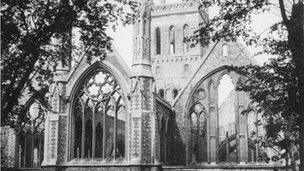Great Yarmouth bombed church tower restored
- Published

The first stage of repairs to restore the historic tower at St Nicholas Minster in Great Yarmouth is coming to an end
The tower of a historic church gutted by German bombs during World War II has been restored.
Scaffolding on the tower at St Nicholas Church, Great Yarmouth, is being dismantled after work costing £380,000.
This is the first phase of a programme to restore stonework, some remaining from the original church completed in 1101, which will cost another £2.5m.
English Heritage provided £180,000 for the first phase and the parish raised the remaining £200,000.
The church was built in the 12th Century by the first bishop of Norwich, Herbert de Losinga, as a penance for selling holy artefacts and promises of salvation (simony).
In 1942 bombs rained down on St Nicholas's and the church was nearly destroyed.
It was rebuilt after the war and rededicated in 1961.
'Phoenix-like restoration'
In December 2011 St Nicholas was designated a minster by the Bishop of Norwich, the Right Reverend Graham James, who said, "Minster churches usually possess both great historical and architectural significance as well as a contemporary mission and ministry stretching beyond immediate parish boundaries."
But much work still had to be done because the legacy of the wartime bombing still remained.

Bombed St Nicholas Picture: 'Norfolk County Council Library and Information Service
Team rector the Rev Chris Terry said the parish was applying for grants and money from the National Lottery to fund the next phases of restoration and to create a conference centre on the north side of the minster.
"It has been a phoenix-like restoration for the minster gutted in June 1942 by German aircraft."
Great Yarmouth was frequently pounded by aircraft that had not dropped their bombs on their designated targets as it was the last town in England before they crossed the North Sea.
Oldest building
During the medieval period the church was at its most magnificent with stained glass, tapestries, painted and gilded walls, frescos, 19 guild chapels, relics of saints and ornate furnishings.
But all that was to disappear when the Puritans took hold of Norfolk and demanded use of the building as their church house.
Brick walls up to 2ft (0.7m) thick were built between its arches and the church was split into three for use by the Anglicans, Puritans and Presbyterians.
The altar tomb of Thomas Crowmer, bailiff of Yarmouth from 1470-97, was destroyed.
Windows were bricked up and part of the church was used by the local militia as a drill hall when the weather was wet.
On the restoration of the monarchy in 1660 the Puritans were ejected from the church but the walls between the arches were not taken down until completion of repair work in 1864.
After that work the church fell into decline and the chancel collapsed.
In the Victorian era prominent people in the town mounted several large and expensive restoration schemes and by 1905 the church had been renovated.
The air raid in 1942 left only the Norman tower and the walls standing.
Mr Terry said: "St Nicholas Church has stood at the end of the Market Place in Great Yarmouth for over 900 years and is arguably the oldest building in the town.
"It is the place where the town gathers for the special civic services for social events such as the Christmas fair, college graduation ceremony and concerts.
"Still other people come to the church to marvel at the architecture and the beautiful clear light that is an important part of the building's visual impact."
- Published20 June 2012